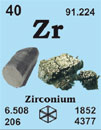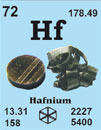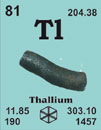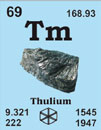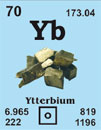& Kristalle GmbH

-
 English
English
-
 Deutsch
Deutsch
Keine Artikel
Gesamt zzgl. MwSt.
Strontium (Sr)
Wir sind führender Hersteller und Lieferant von Forschungsmaterialien
Strontium 38Sr87.62
1790 von A. Crawford in Edingburg, Schottland, als Element erkannt. 1808 von Sir Humphry Davy in London, UK, dargestellt.
[Nach Strontian, Schottland, benannt]
French: strontium
English: strontium
Italian: stronzio
Spanish: estroncio
Beschreibung: Silberweißes, weiches Metall, das man durch Reduktion von SrO mit Al bei hohen Temperaturen erhält. Kompaktes Metall wird durch eine Oxidhaut geschützt, aber es verbrennt an Luft und reagiert mit Wasser. Verwendung in Spezialgläsern und in der Pyrotechnik, um Rotfärbung zu erzeugen.
Further Materials properties
| Crystal structure: |
(cell dimensions/pm), space group, |
|---|---|
| X-ray diffractions mass absorption coefficients: | CuKa 125 (µ/r) / cm2g-1 MoKa 95.0 (µ/r) / cm2g-1 |
| Neutron scattering length: | 0.702 b/10-12 cm |
| Thermal neutron capture cross-section: | 1.28 sa / barns |
| Density: | 2540 kg/m-3 [293 K]; 2375 [liquid at m.p.] |
| Melting point: | 768.85°C / 1042°K |
| Boiling point: | 1383.85°C / 1657°K |
| Molar volume: | 34.50 cm3 |
| Thermal conductivity: | 35.3 [300 K] W m-1K-1 |
| Coefficient of linear thermal expansion: | 23 x 10-6 K-1 |
| Electrical resistivity: | 23.0 x 10-8 [295 K] Ωm |
| Mass magnetic susceptibility: | +1.32 x 10-8(s) kg-1m3 |
| Radi: | Sr2+ 127; atomic 215 (α-form); covalent 192 |
| Electronegativity: | 0.95 (Pauling); 0.99 (Allred); 2.0 eV (absolute) |
| Effective nuclear charge: | 2.85 (Slater); 6.07 (Clementi); 8.09 (Froese-Fischer) |
| Number of Isotopes (incl. nuclear isomers): | 23 |
| Isotope mass range: | 79 -> 98 |
Biological data
| Biological role: | None. |
|---|---|
| Toxicity | |
| Toxic intake: | not regarded as toxic |
| Lethal intake: | LD50 (chloride, oral, rat) = 2250 mg Kg-1 |
| Hazards: | Strontium resembles calcium in metabolism and behaviour and is absorbed by the body and stored in the skeleton. This also happens with radioactive 90Sr. which was produced by above-ground nuclear explosions in the 1950s and is widely disseminated in the environment. |
| Level in humans | |
| Blood: | 0.031 mg dm-3 |
| Bone: | 36 - 140 ppm |
| Liver: | 0.05 - 0.36 ppm |
| Muscle: | 0.12 - 0.35 ppm |
| Daily dietary intake: | 0.8 - 5 mg |
| Total mass of element in average [70 kg] person: |
320 mg |
Geological data
| Minerals: | ||||
|---|---|---|---|---|
| Mineral | Formula | Density | Hardness | Crystal apperance |
| Clestite* | SrSO4 | 3.97 | 3 - 3.5 | orth., vit./ colourless-pale blue |
| Strontianite | SrCO3 | 3.76 | 3.5 | orth., vit./ resinous colourless |
| Chief ores: | celestite, strontianite |
|---|---|
| World production: | 137 000 (strontium ores) tonnes/year |
| Producing areas: | UK, Tunisia, Russia, Germany, Mexico, USA |
| Reserves: | n.a. |
| Specimen: | available as granules and pieces. Warning! |
| Abundances | |
|---|---|
| Sun: | 790 (relative to H = 1 x 1012) |
| Earth's crust: | 370 ppm |
| Seawater | |
| Atlantic surface: | 7.6 ppm |
| Atlantic deep: | 7.7 ppm |
| Pacific surface: | 7.6 ppm |
| Pacific deep: | 7.7 ppm |
| Residence time: | 4 x 106 years |
| Classification: | recycled |
| Oxidation state: | II |
Source: Emsley, J. (1998) The Elements (3rd Edition)
Other sizes and specifications on request
Übersicht der Elemente mit Zugang zu unserem Shop
Fax: +49 (0) 2461 - 9352 - 11








































